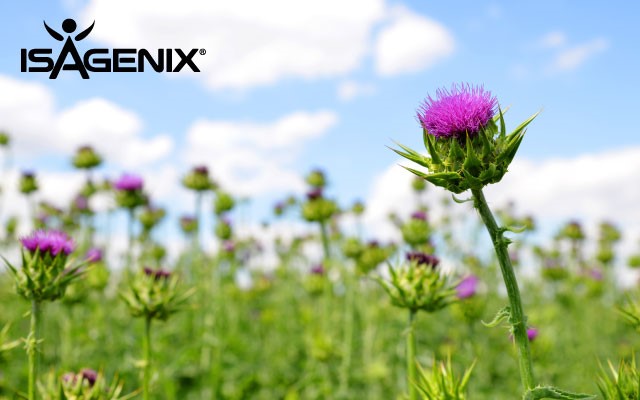During the development of Isagenix Product B and its subsequent reformulation as IsaGenesis®, one of the goals was to provide an optimal blend of herbal extracts and bioactive nutrients that would protect the body by helping to bolster antioxidant defenses. And among those important herbal extracts was milk thistle (Silybum marianum).
What is milk thistle? To better understand this plant – whose family includes sunflowers and daisies – let’s delve into the basics: its bioactive components and research surrounding its physiological and biochemical effects.
Ancient Egypt to Modern Day Scientific Investigations
Milk thistle is native to the Mediterranean region although now it grows worldwide in cultivated and wild form. It gets its name from the milky white sap that exudes from its leaves when crushed. Human use of milk thistle has been traced back to ancient Egypt where archeological evidence suggests Egyptians frequently sought out its benefits (1). More recently, clinical assessments of milk thistle were performed by German physicians who investigated its potential support for the liver (2).
Milk Thistle Provides Significant Biological Activities
The name milk thistle is often used interchangeably with the term silymarin, which is the extract that contains most of the plant’s biological activity. Silymarin in turn consists of a class of natural molecules called flavonolignans. The most important of these molecules is known as silibinin.
Scientific studies into the effects of milk thistle have found that the plant offers a myriad of functional benefits including support for the heart, brain, and liver. Research suggests that milk thistle may help support liver cells that are exposed to alcohol or other toxic substances, scavenge free radicals, increase levels of glutathione – the body’s major antioxidant – and help modulate immune functions (3-5).
In clinical studies, milk thistle supplementation has also been shown to increase antioxidant enzyme activity, while reducing a variety of biomarkers of oxidative stress (6, 7).
Enhancement of a “Longevity” Antioxidant Enzyme by Product B IsaGenesis
Recently IsaGenesis, which includes milk thistle among its herbal bioactive ingredients, was evaluated in a double-blind, placebo-controlled study at Arizona State University. Impressively, the researchers observed a significant increase in levels of the antioxidant enzyme catalase in subjects who consumed the supplement (8).
This enzyme is the cell’s primary defender against oxidative stress from excessive production of hydrogen peroxide. Produced as a byproduct of normal metabolism, hydrogen peroxide is particularly damaging to telomeres and it can accelerate their rate of shortening.
IsaGenesis Provides a Bioavailable and Quality Source of Milk Thistle
Subsequent to this finding, further development of IsaGenesis optimized bioavailability of its herbal bioactive components with specific natural bioenhancers such as phosphatidylcholine, a process that has been demonstrated for milk thistle (9, 10).
The clinical research focusing on IsaGenesis alone should be testament enough that Isagenix provides milk thistle of the highest quality. The ingredient is rigorously tested to be sure it contains an appropriate dose of active components. It’s also tested for the presence of possible adulterants or contaminants such as heavy metals or pesticides. The product provides a safe, effective dose containing sufficient bioactive components for any adult seeking its liver- and cellular-health benefits.
Because the product contains no animal ingredients, it’s also appropriate for vegetarians. However, like all herbal-containing products, it’s not recommended for use by pregnant or nursing women or for those under the age of 18.
References
- Federico A et al. Silymarin/Silybin…: A Marriage of Many Years. Molecules 2017;22. Pii: E191.
- Luper S. A review of plants…: part 1. Altern Med Rev 1998;3:410-210.
- Salmin HA and Sarna S. Effect of silymarin on chemical, functional, and morphological alterations of the liver. A double-blind controlled study. Scand J Gastroenterol 1982;17:517-21.
- Polyak SJ et al. Identification of hepatoprotective flavonolignans from silymarin. Proc Natl Acad Sci 2010;107:5995-9.
- Ferenci P. Silymarin…: What is the clinical evidence? Clin Liv Dis 2016;7:8-10.
- Ebrahimpour Koujan S et al. Effects of Silybum marianum (L.) Gaertn. (silymarin) extract supplementation on antioxidant status and hs-CRP in patients with type 2 diabetes mellitus: a randomized, triple-blind, placebo-controlled clinical trial. Phytomedicine 2015; 22:290-6.
- Velussi M et al. Long-term (12 months) treatment with an anti-oxidant drug (silymarin) is effective on hyperinsulinemia, exogenous insulin need and malondialdehyde levels in cirrhotic diabetic patients. J Hepatol 1997;26:871-9.
- Sweazea K et al. Plant-Based Nutraceutical Increases Plasma Catalase Activity in Healthy Participants: A Small Double-Blind, Randomized, Placebo-Controlled, Proof of Concept Trial. J Diet Suppl 2017;14:200-13.
- Kidd P and Head K. A review of the bioavailability and clinical efficacy of milk thistle phytosome: a silybin-phosphatidylcholine complex (Siliphos). Altern Med Rev 2005;10:193-203.
- Yanyu X et al. The preparation of silybin-phospholipid complex and the study on its pharmacokinetics in rats. Int J Pharm 2006;307:77-82.





